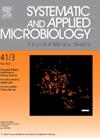Taxonomic description and genome sequence of Anaerorudis cellulosivorans gen. Nov. sp. nov., a novel cellulose- and Xylan-degrading bacterium of the Bacteroidota phylum isolated from a lab-scale methanogenic landfill bioreactor digesting municipal solid waste
IF 4.2
2区 生物学
Q2 BIOTECHNOLOGY & APPLIED MICROBIOLOGY
引用次数: 0
Abstract
Bacteria responsible for the anaerobic decomposition of lignocellulosic waste biomass play key roles in the global carbon cycle and possess enzymes with potential industrial application. Here, a novel anaerobic, thermophilic, non-spore-forming bacterium, strain m5T, was isolated from methanogenic enrichment cultures obtained from a lab-scale methanogenic landfill bioreactor digesting anaerobic municipal solid waste. Cells were Gram-stain-negative, catalase-negative, oxidase-negative, rod-shaped, and non-motile. The genomic DNA G + C content was 40.92 mol%. The optimal NaCl concentration, temperature and pH for growth were 0.5–1 g.L−1, 45 °C, and at pH 7.0, respectively. The major fatty acids were C14:0, C16:0, C18:0, C18:1 ω9c, and anteisoC15:0. Strain m5T was able to grow in the absence of yeast extract on glucose, fructose, arabinose, cellobiose, galactose, maltose, raffinose, sucrose, lactose, and pyruvate. In the presence of 0.2 % yeast extract, strain m5T grew on wide range of carbohydrates and amino acids, and was able to use complex substrates such cellulose and xylan. Major end products from cellulose and xylan degradation were valerate and propionate. Phylogenetic analysis based on 16S rRNA gene sequences indicated that the new isolate was most closely related to Seramator thermalis SYSU GA16112T (94.42 % 16S rRNA gene sequence identity). Genome-based relatedness as well as both Average Nucleotide Identity (ANI), and Average Amino Acid Identity (AAI) strongly supported that strain m5T belongs to the Dysgonomonadaceae family. Metagenomic analysis of the landfill bioreactor community revealed that the Dysgonomonadaceae family was the most abundant in the constructed bioreactors. Based on its unique genomic features, strain m5T is considered to represent a novel genus, for which the name Anaerorudis is proposed. Moreover, several phenotypic, biochemical, and physiological properties differentiated the novel bacterial strain from related species, indicating that the strain represents a new species for which the name Anaerorudis cellulosivorans sp. nov. is proposed, with strain m5T (= DSM 112743T = ATCC TSD-267T) being the type of strain. This study highlights the biotechnological potential of strain m5T, specifically in the bioconversion of cellulose and xylan, a recalcitrant substrate within lignocellulosic plant biomass, to enhance biogas production.
厌氧细菌cellulosivorans gen. nov. sp. nov.的分类描述和基因组序列,这是一种从消化城市固体废物的实验室规模的产甲烷垃圾填埋场生物反应器中分离出来的新型纤维素和木聚糖降解细菌
负责木质纤维素废弃物厌氧分解的细菌在全球碳循环中发挥着关键作用,并且具有潜在的工业应用潜力。在这里,一种新的厌氧、嗜热、不形成孢子的细菌,菌株m5T,从消化厌氧城市固体废物的实验室规模的甲烷填埋场生物反应器中获得的甲烷富集培养物中分离出来。革兰氏染色阴性,过氧化氢酶阴性,氧化酶阴性,杆状,无运动。基因组DNA G + C含量为40.92 mol%。适宜生长的NaCl浓度、温度和pH为0.5 ~ 1 g。L−1,45°C, pH 7.0。主要脂肪酸为C14:0、C16:0、C18:0、C18:1 ω9c和前ω 15:0。菌株m5T能够在没有酵母提取物的情况下在葡萄糖、果糖、阿拉伯糖、纤维素糖、半乳糖、麦芽糖、棉子糖、蔗糖、乳糖和丙酮酸盐上生长。在0.2%酵母提取物的存在下,菌株m5T在广泛的碳水化合物和氨基酸上生长,并且能够使用复杂的底物,如纤维素和木聚糖。纤维素和木聚糖降解的主要最终产物是戊酸盐和丙酸盐。基于16S rRNA基因序列的系统发育分析表明,新分离物与Seramator thermalis SYSU GA16112T亲缘关系最为密切(16S rRNA基因序列同源性为94.42%)。基于基因组的亲缘关系以及平均核苷酸识别(ANI)和平均氨基酸识别(AAI)强烈支持菌株m5T属于Dysgonomonadaceae家族。对垃圾填埋场生物反应器群落进行宏基因组分析,发现所建生物反应器中最丰富的是Dysgonomonadaceae科植物。基于其独特的基因组特征,菌株m5T被认为代表了一个新的属,并建议将其命名为厌氧菌。此外,该新菌株的表型、生化和生理特征与相关物种有所不同,表明该菌株代表了一种新种,并被命名为厌氧菌纤维素细菌sp. 11,菌株m5T (= DSM 112743T = ATCC TSD-267T)为菌株类型。这项研究强调了菌株m5T的生物技术潜力,特别是在纤维素和木聚糖(木质纤维素植物生物质中的一种顽固性底物)的生物转化方面,以提高沼气产量。
本文章由计算机程序翻译,如有差异,请以英文原文为准。
求助全文
约1分钟内获得全文
求助全文
来源期刊

Systematic and applied microbiology
生物-生物工程与应用微生物
CiteScore
7.50
自引率
5.90%
发文量
57
审稿时长
22 days
期刊介绍:
Systematic and Applied Microbiology deals with various aspects of microbial diversity and systematics of prokaryotes. It focuses on Bacteria and Archaea; eukaryotic microorganisms will only be considered in rare cases. The journal perceives a broad understanding of microbial diversity and encourages the submission of manuscripts from the following branches of microbiology:
 求助内容:
求助内容: 应助结果提醒方式:
应助结果提醒方式:


